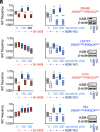SOS1 and KSR1 modulate MEK inhibitor responsiveness to target resistant cell populations based on PI3K and KRAS mutation status
- PMID: 37972068
- PMCID: PMC10666034
- DOI: 10.1073/pnas.2313137120
SOS1 and KSR1 modulate MEK inhibitor responsiveness to target resistant cell populations based on PI3K and KRAS mutation status
Abstract
KRAS is the most commonly mutated oncogene. Targeted therapies have been developed against mediators of key downstream signaling pathways, predominantly components of the RAF/MEK/ERK kinase cascade. Unfortunately, single-agent efficacy of these agents is limited both by intrinsic and acquired resistance. Survival of drug-tolerant persister cells within the heterogeneous tumor population and/or acquired mutations that reactivate receptor tyrosine kinase (RTK)/RAS signaling can lead to outgrowth of tumor-initiating cells (TICs) and drive therapeutic resistance. Here, we show that targeting the key RTK/RAS pathway signaling intermediates SOS1 (Son of Sevenless 1) or KSR1 (Kinase Suppressor of RAS 1) both enhances the efficacy of, and prevents resistance to, the MEK inhibitor trametinib in KRAS-mutated lung (LUAD) and colorectal (COAD) adenocarcinoma cell lines depending on the specific mutational landscape. The SOS1 inhibitor BI-3406 enhanced the efficacy of trametinib and prevented trametinib resistance by targeting spheroid-initiating cells in KRASG12/G13-mutated LUAD and COAD cell lines that lacked PIK3CA comutations. Cell lines with KRASQ61 and/or PIK3CA mutations were insensitive to trametinib and BI-3406 combination therapy. In contrast, deletion of the RAF/MEK/ERK scaffold protein KSR1 prevented drug-induced SIC upregulation and restored trametinib sensitivity across all tested KRAS mutant cell lines in both PIK3CA-mutated and PIK3CA wild-type cancers. Our findings demonstrate that vertical inhibition of RTK/RAS signaling is an effective strategy to prevent therapeutic resistance in KRAS-mutated cancers, but therapeutic efficacy is dependent on both the specific KRAS mutant and underlying comutations. Thus, selection of optimal therapeutic combinations in KRAS-mutated cancers will require a detailed understanding of functional dependencies imposed by allele-specific KRAS mutations.
Keywords: KSR1; RAS; SOS1; resistance; trametinib.
Conflict of interest statement
The Kortum laboratory receives funding from Boehringer Ingelheim to study SOS1 as a therapeutic target in
Figures






References
-
- Reck M., Carbone D. P., Garassino M., Barlesi F., Targeting KRAS in non-small-cell lung cancer: Recent progress and new approaches. Ann. Oncol. 32, 1101–1110 (2021). - PubMed
Publication types
MeSH terms
Substances
Grants and funding
LinkOut - more resources
Full Text Sources
Medical
Molecular Biology Databases
Research Materials
Miscellaneous

